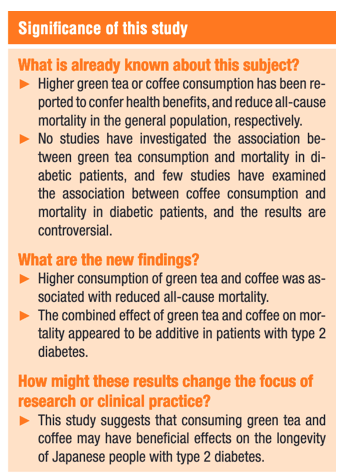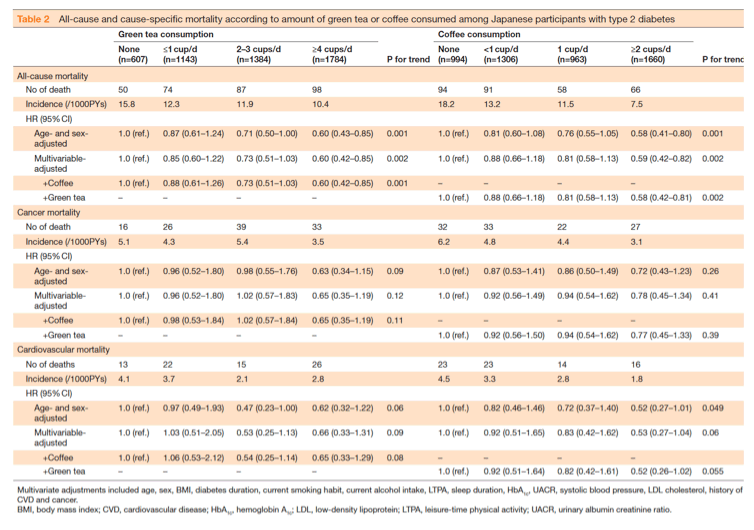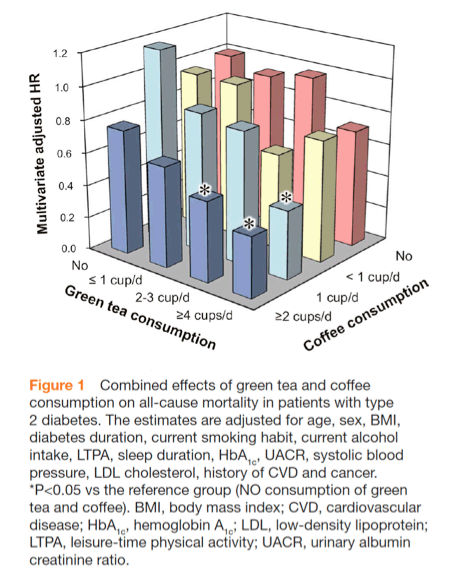| |
Additive effects of green tea and coffee on all-cause mortality in patients with type 2 diabetes mellitus: the Fukuoka Diabetes Registry
|
| |
| |
Download the PDF here
• the combination of higher green tea and coffee consumption significantly reduced all-cause mortality risk by 63%.
• To our knowledge, this is the first study to identify an association between higher green tea consumption and decreased all-cause mortality in type 2 diabetes patients.
Multivariable-adjusted hazard ratios (95% CIs) for green tea were as follows:
none 1.0 (referent);
• 0.85 (0.60-1.22) for ≤1 cup/day;
• [27% reduction] 0.73 (0.51-1.03) for 2-3 cups/day;
• [40% reduction] 0.60 (0.42-0.85) for ≥4 cups/day [40% reduction]; and P for trend, 0.002.
For coffee, they were: none 1.0 (referent);
• 0.88 (0.66-1.18) for <1 cup/day [12%];
• 0.81 (0.58-1.13) for 1 cup/day [19%]; 0.59 (0.42-0.82) for ≥2 cups/day [41%] ; P for trend, 0.002.
With the combination they were 1.0 (referent) for no consumption of green tea and coffee;
• [41% reduction] 0.49 (0.24-0.99) for 2-3 cups/day of green tea with ≥2 cups/day of coffee;
• [58% reduction] 0.42 (0.20-0.88) for ≥4 cups/day of green tea with 1 cup/day of coffee; and
• [63% reduction] 0.37 (0.18-0.77) for ≥4 cups/day of green tea with ≥2 cups/day of coffee.

In the green tea groups, all-cause mortality significantly decreased according to the amount of green tea consumed (P for trend, 0.001).
The multivariable-adjusted HR was significantly lower in participants who consumed ≥4 cups/day of green tea compared with those who did not drink green tea - [reduced by 40%] (HR, 0.60; 95% CI, 0.42 to 0.85).
Figure 1 shows the multivariable-adjusted HRs of all-cause mortality according to combined green tea and coffee consumption. When the mortality in participants drinking neither green tea nor coffee was set as the referent, multivariable-adjusted HRs were significantly reduced as follows:
in those consuming 2-3 cups of green tea with ≥2 cups/day of coffee -[reduced by 51%] (HR, 0.49; 95% CI, 0.24 to 0.99); consuming ≥4 cups/day of green tea with 1 cup/day of coffee - reduced by 58% (HR, 0.42; 95% CI, 0.20 to 0.88); and drinking ≥4 cups of green tea with ≥2 cups/day of coffee - [reduced by 63%] (HR, 0.37; 95% CI, 0.18 to 0.77) (table 3).
Abstract
Introduction The impact of consuming green tea or coffee on mortality in patients with diabetes is controversial. We prospectively investigated the impact of each beverage and their combination on mortality among Japanese patients with type 2 diabetes.
Research design and methods In all, 4923 patients (2790 men, 2133 women) with type 2 diabetes (mean age, 66 years) were followed prospectively (median, 5.3 years; follow-up rate, 99.5%). We evaluated the amount of green tea and coffee consumed using self-administered questionnaires.
Study participants
The Fukuoka Diabetes Registry is a multicenter prospective study (UMIN Clinical Trial Registry 000002627) designed to investigate the effect of modern treatments and lifestyles on the prognoses of patients with diabetes mellitus. The registry includes patients who regularly attended teaching hospitals certified by the Japan Diabetes Society or certified diabetes clinics in Fukuoka Prefecture, Japan.22 In all, 5131 patients with diabetes mellitus aged 20 years or older were registered during regular visits between April 2008 and October 2010. The registry exclusion criteria were as follows: patients with drug-induced diabetes or those undergoing corticosteroid treatment; patients undergoing renal replacement therapy; patients with serious diseases other than diabetes, such as advanced malignancies and decompensated liver cirrhosis; and patients unable to visit diabetologists regularly. After excluding 208 participants with type 1 diabetes, we enrolled the remaining 4923 participants in this study.
Results During the follow-up period, 309 participants died. The consumption of green tea, coffee, and a combination of the beverages was associated with reduced all-cause mortality.
Multivariable-adjusted hazard ratios (95% CIs) for green tea were as follows: none 1.0 (referent); 0.85 (0.60-1.22) for ≤1 cup/day; [27% reduction] 0.73 (0.51-1.03) for 2-3 cups/day; [40% reduction] 0.60 (0.42-0.85) for ≥4 cups/day [40% reduction]; and P for trend, 0.002.
For coffee, they were: none 1.0 (referent); 0.88 (0.66-1.18) for <1 cup/day [12%]; 0.81 (0.58-1.13) for 1 cup/day [19%]; 0.59 (0.42-0.82) for ≥2 cups/day [41%] ; P for trend, 0.002.
With the combination they were 1.0 (referent) for no consumption of green tea and coffee; [41% reduction] 0.49 (0.24-0.99) for 2-3 cups/day of green tea with ≥2 cups/day of coffee; [58% reduction] 0.42 (0.20-0.88) for ≥4 cups/day of green tea with 1 cup/day of coffee; and [63% reduction] 0.37 (0.18-0.77) for ≥4 cups/day of green tea with ≥2 cups/day of coffee.
Conclusions Higher consumption of green tea and coffee was associated with reduced all-cause mortality: their combined effect appeared to be additive in patients with type 2 diabetes.
During the follow-up period (median, 5.3 years; follow-up rate, 99.5%), 309 participants (218 men, 91 women) died. The main causes of death were cancer (n=114) and CVD (n=76). Table 2 presents the number of all-cause and cause-specific deaths, crude incidence, multivariable-adjusted HRs, and 95% CIs according to the green tea and coffee consumption groups. In the green tea groups, all-cause mortality significantly decreased according to the amount of green tea consumed (P for trend, 0.001). The multivariable-adjusted HR was significantly lower in participants who consumed ≥4 cups/day of green tea compared with those who did not drink green tea (HR, 0.60; 95% CI, 0.42 to 0.85). Further, the HR remained significant after additional adjustments for coffee consumption. Cause-specific mortality for cancer was not associated with the amount of green tea consumed: the association of the amount of green tea consumed with CVD was marginally insignificant (P for trend, 0.08). In the coffee groups, all-cause mortality was also significantly reduced according to the amount of coffee consumed (P for trend, 0.001). The multivariable-adjusted HR was significantly lower in participants who consumed ≥2 cups/day of coffee than in those who did not consume coffee (HR, 0.59; 95% CI, 0.42 to 0.82). That association remained significant after further adjustments for green tea consumption. Cause-specific mortality for cancer was not associated with the amount of coffee consumed: the association of the amount of coffee consumption with CVD was marginally insignificant (P for trend, 0.06).
Conclusions
In this prospective study, we found that higher green tea and coffee consumption was significantly associated with decreased all-cause mortality in patients with type 2 diabetes. This association remained significant after adjusting for potential confounders: the impact of each beverage on mortality was independent. Similar trends were evident in analyzes of CVD-specific mortality. Further, the combination of higher green tea and coffee consumption significantly reduced all-cause mortality risk by 63%.
Hitherto, little research has investigated the association between green tea consumption and mortality in diabetic patients. Some epidemiological studies from Japan and China have reported the association between green tea consumption and mortality in the general population, including diabetic and non-diabetic individuals. The Ohsaki Study was the first large-scale investigation on this subject: among 40 530 Japanese men and women, it found that those who consumed ≥5 cups/day of green tea had a 15% lower risk of all-cause mortality than those drinking <1 cup/day.6 A meta-analysis of five cohort studies of the general population (including diabetic and non-diabetic individuals) demonstrated that the HRs (95% CIs) of the highest vs the lowest green tea consumption were 0.80 (0.68-0.93) for all-cause mortality and 0.67 (0.46-0.96) for CVD mortality.7 The results of the present study are consistent with those of previous studies of the general population (including diabetic and non-diabetic individuals): however, we found the impact of green tea consumption to be even greater (HR for the highest vs lowest consumption, 0.60). To our knowledge, this is the first study to identify an association between higher green tea consumption and decreased all-cause mortality in type 2 diabetes patients.
The association between coffee consumption and mortality has been controversial in diabetic patients, although most studies have described beneficial effects in general populations (including diabetic and non-diabetic individuals). This association with diabetic patients was initially investigated with a Finnish diabetic population (3837 individuals) in 2006: a 30% significant reduction in all-cause mortality was observed in those who consumed ≥7 cups/day of coffee compared with those drinking 0-2 cups/day.16 However, the Health Professionals Follow-up Study of 3497 male diabetic patients found no association between coffee consumption and all-cause or CVD mortality.17 The National Health and Nutrition Examination Survey recently found that ≥200 mg/day of caffeine from coffee reduced all-cause mortality among 1974 women with diabetes, but not among men.19 Some large-scale studies of general populations have attempted to identify associations in subgroup analyses of diabetic patients. The National Institutes of Health-American Association of Retired Persons Diet and Health Study (total n=2 46 433) found that consuming ≥4 cups/day of coffee was associated with a 19% significant reduction of all-cause mortality in men and 14% insignificant reduction in women with self-reported diabetes.12 Similarly, in a US prospective cohort with 90 317 participants, drinking ≥4 cups/day of coffee was significantly associated with reduced all-cause mortality in diabetic patients.13 Conversely, in a Dutch population, the Alpha Omega Study involving 4837 patients with prior myocardial infarction determined that consuming more than four cups/day of coffee increased mortality by 24% in diabetic patients, whereas it decreased mortality by 27% in those without diabetes.14 In the Nurses’ Health Study (7170 female patients with diabetes), habitual coffee consumption was not found to be associated with increased risk of mortality.18 The UK Biobank (total n=498 134 participants) failed to identify a significant association between coffee consumption and mortality in diabetic patients.15 Most of the above studies were conducted in developed country populations, which have a higher risk of CVD than those in Asia.20 To our knowledge, the present investigation is the first prospective study to demonstrate a significant association between coffee consumption and reduced mortality in an Asian population with type 2 diabetes.
The mechanisms underlying reduced mortality with green tea and coffee consumption are not fully understood. Green tea contains a number of beneficial substances, including phenolic compounds, theanine, and caffeine.4 8 Epigallocatechin gallate is the most prevalent phenolic compound: it has been shown to have antioxidant, anti-inflammatory, and anti-mutagenic properties.27 Coffee also contains numerous bioactive components, including phenolic compounds and caffeine, which have been suggested as contributing to the associated favorable effects.9 Phenolic compounds, such as chlorogenic acid, have been reported to have a health impact through various mechanisms, such as antioxidant and anti-inflammatory actions.9 28
Caffeine is one of the components in green tea and coffee that could contribute to their favorable effects. The beneficial effects of caffeine on insulin sensitivity and glucose-induced insulin secretion have been suggested29 through several mechanisms, including weight loss and thermogenesis.30 31 However, previous studies have found that consumption of both caffeinated and decaffeinated coffee was associated with reduced mortality.12 That could mean that caffeine does not play a beneficial role in the association between coffee consumption and risk of mortality. Caffeine has also been reported to stimulate sympathetic activity and increase serum catecholamine levels,32 leading to increased blood pressure or CVD risk.11 33 The impact of coffee consumption on mortality was greater in the present study (HR 0.58) than that previously reported in developed country diabetic patients: HR 0.81 in men,12 HR 0.76,13 HR 0.70,16 and HR 0.53 in women.19 The difference may be explained by coffee having harmful effects among patients at higher CVD risk: that is based on findings that higher coffee consumption increased mortality among diabetic patients with previous myocardial infarction.14 Japanese type 2 diabetes patients are generally at lower CVD risk than developed ones:20 thus, caffeine may exert less detrimental effects on the vasculature, resulting in enhanced beneficial effects of coffee.
To date, no study has investigated the combined effect of green tea and coffee consumption on all-cause mortality. The present study determined that combined higher green tea and coffee consumption markedly reduced mortality. The Japan Public Health Center-Based Study found that the combination of ≥2 cups/day of green tea and ≥1 cup/day of coffee significantly reduced the risk for cerebral infarction and intracerebral hemorrhage.34 However, that effect did not apply to CHD: the study found no impact on CHD mortality. We found that the relative risk reduction of mortality (HR, 0.37) was greater than when consuming only green tea (HR, 0.72) or only coffee (HR, 0.76; figure 1, table 3), thus, the protective mechanisms of the two beverages may differ. In addition to CVD and cancer, coffee reportedly confers health benefits with liver disease and dementia,10 however, reduced mortality associated with green tea is mostly explained with respect to CVD or cancer.7 8 Green tea and coffee consumption may be associated with different disease incidence or severity.
One strength of the present study is the high follow-up rate (99.5%), which enabled us to accurately investigate the association among green tea and coffee consumption and mortality. Further, this cohort study included potential confounders, such as sleep duration, diabetic complications, lifestyle, physical activity, laboratory data, and medications.
Some limitations of this study deserve mention. First, green tea and coffee consumption was assessed using single, self-reported data, which raises the problem of potential misclassification. However, the green tea and coffee consumption evaluated using our questionnaire showed high correlation with that found with 16 non-consecutive dietary records in a Japanese population.25 Second, we did not obtain information about some other confounding factors, such as educational and socioeconomic levels. Higher educational or income levels may be associated with greater coffee consumption:35 they may also be related to lower mortality risk.36 Those factors may be considered by adjusting for physical activities or smoking status, which could be associated with higher educational or income levels.36 However, a universal health insurance system has been established in Japan, thus, medical care is supposedly received regardless of educational or socioeconomic states. Third, the CVD medications differed among the coffee groups (table 1). Those medications were not considered in the analyses, however, history of CVD was included as a confounding factor. Fourth, we did not assess whether coffee was caffeinated or decaffeinated. However, decaffeinated coffee is uncommon in Japan. Previous studies have found a similar association between caffeinated or decaffeinated coffee and mortality.12 13 Fifth, owing to the observational nature of the present study, we cannot conclude that consuming green tea or coffee reduces mortality. But long-term interventional studies of this kind may be difficult to implement: green tea and coffee are typically consumed as part of daily life. Sixth, the number of cause-specific deaths was relatively small. That could lead to low statistical power in detecting significant associations. Seventh, there may have been multiple testing problems in our statistical analyses. Multiple testing corrections were not conducted in the present study, however, the results of table 2 are evidently consistent with those of previous studies.15 37 38 Finally, this study was conducted only among a Japanese population. The ingredients of Japanese green tea could differ from those in green tea in other countries.39 Accordingly, the findings of this study may not apply to other populations.
In conclusion, this prospective cohort study demonstrated that greater consumption of green tea and coffee was significantly associated with reduced all-cause mortality: the effects may be additive. Our results suggest that consuming green tea and coffee may have beneficial effects on the longevity of Japanese people with type 2 diabetes.


|
|
| |
| |
|
|
|